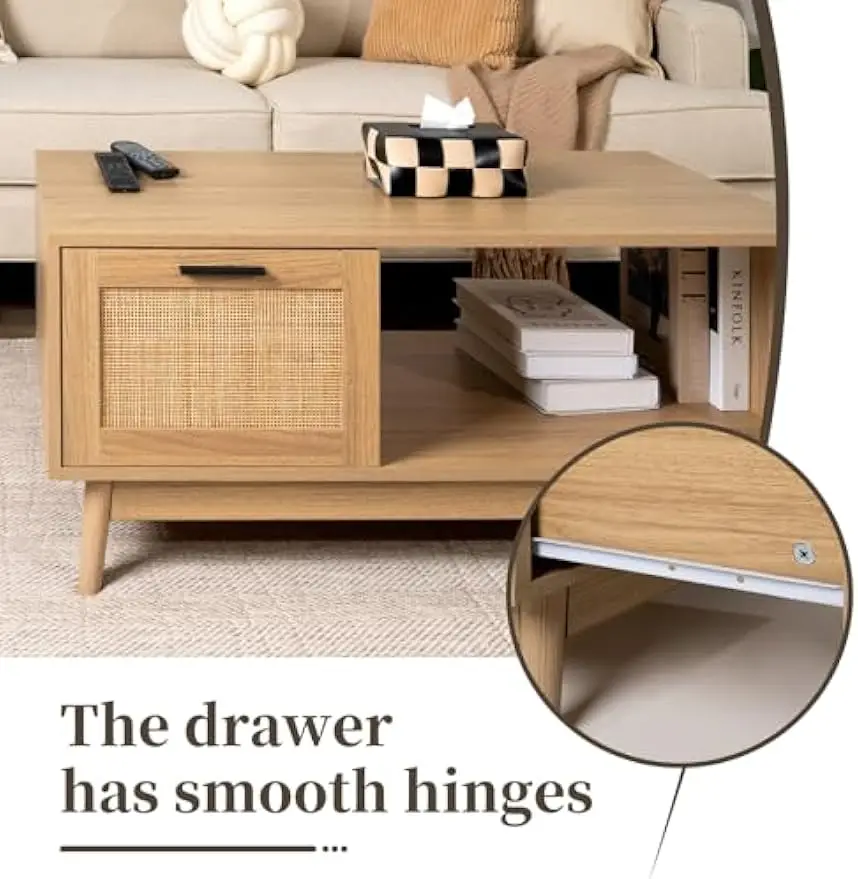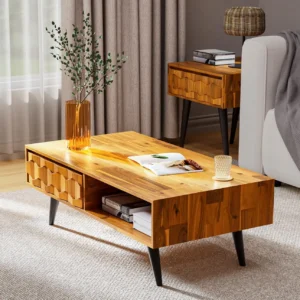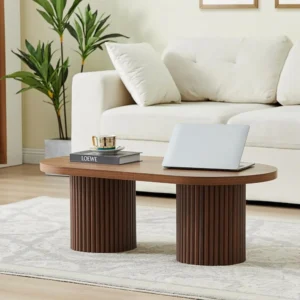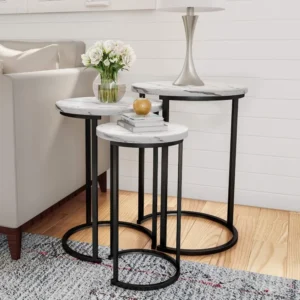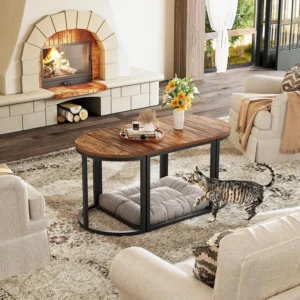The Timeless Appeal of Vintage Coffee Tables
Vintage coffee tables possess a unique charm that modern reproductions simply cannot match. What makes a coffee table truly “vintage” goes beyond mere age—it encompasses authentic materials like solid hardwoods, superior craftsmanship with dovetail joints or hand-carved details, and distinctive design elements that reflect specific eras of furniture making.
These timeless pieces continue to captivate homeowners and designers alike because they bring character, history, and unmatched uniqueness to living spaces. Unlike mass-produced furniture, vintage tables tell stories through their patina, subtle imperfections, and design heritage. They naturally become conversation starters and focal points in modern homes, drawing attention while anchoring the surrounding decor.
What makes vintage coffee tables particularly special is their perfect balance between beauty and functionality. These pieces were designed when craftspeople prioritized both aesthetic appeal and practical use—creating furniture meant to last generations while being used daily.
In this guide, you’ll discover practical approaches to styling rooms around black mid-century coffee tables and other vintage pieces, learning how to highlight their unique features while creating cohesive, inviting spaces. The enduring popularity of styles like Mid-Century Modern and Art Deco demonstrates that good design truly transcends time, with these vintage pieces seamlessly integrating into today’s interiors while adding sustainable value through reuse rather than replacement.
Whether you’ve inherited a family heirloom or discovered a special piece at an estate sale, your vintage coffee table deserves to be showcased among our carefully selected collection of mid-century modern vintage coffee tables.
Understanding Your Vintage Coffee Table’s Character
Before styling your space, take time to appreciate what makes your vintage coffee table special. Different eras produced distinctly different pieces, each with unique characteristics worth highlighting:
Mid-Century Modern (1940s-1970s)
* Clean, organic lines with minimal ornamentation
* Tapered, angled legs
* Woods like teak, walnut, and rosewood
* Often features geometric shapes or biomorphic forms
Art Deco (1920s-1930s)
* Bold geometric patterns and symmetry
* Exotic wood veneers and inlays
* Chrome, brass, or glass accents
* Stepped or curved forms
Victorian (1837-1901)
* Ornate carvings and decorative details
* Dark woods like mahogany or walnut
* Cabriole legs or turned spindles
* Often features marble tops
Industrial (Early 20th century)
* Raw materials like reclaimed wood and metal
* Exposed hardware and mechanical components
* Utilitarian design with visible function
* Often features wheels or adjustable components
Pay attention to your table’s material composition, which significantly impacts styling choices. Many vintage pieces use solid hardwoods that display beautiful grain patterns worth highlighting. Look for distinctive joinery methods—like finger joints or dowel construction—that reveal craftsmanship quality.
Examining your table’s proportions also matters; vintage pieces often have different dimensions than contemporary tables. Many vintage coffee tables sit lower than modern versions and may be longer, wider, or have unusual shapes.
When assessing condition, determine if imperfections add character or need attention. Light scratches and patina often enhance a vintage piece’s authenticity and charm, while structural issues or significant damage might require professional restoration.
Understanding these distinctive characteristics helps when identifying Danish-inspired coffee tables or other vintage styles. Hearth Forms offers a selection of authentic Danish coffee tables that exemplify many of these classic characteristics.
Foundational Design Principles for Styling Success
Creating a harmonious space around your vintage coffee table requires understanding key design principles that will guide all your styling decisions:
Visual Balance: Create equilibrium between your vintage coffee table and modern elements to avoid a space feeling disjointed. If your table has substantial visual weight (dark wood, heavy construction), balance it with lighter elements elsewhere, and vice versa.
Focal Point Strategy: Decide if your vintage coffee table will serve as the room’s primary focal point or support another statement piece. This decision affects how boldly you’ll style the table and surrounding space.
Scale and Proportion: Ensure your coffee table size complements your seating arrangement. The ideal coffee table typically stands 16-18 inches tall and should be about two-thirds the length of your sofa. Vintage tables that don’t meet these proportions may require creative arrangement of surrounding furniture.
Negative Space: Resist overcrowding your vintage piece. Allow breathing room around special details or interesting wood grain patterns. This negative space helps highlight what makes your table unique.
Color Harmony: Use your vintage table’s dominant tones to inform other color choices. For wood tables, identify whether the undertones are warm (red, orange, yellow) or cool (gray, blue) and select complementary colors accordingly.
The 70/30 Rule: For a cohesive look that still feels fresh, aim for approximately 70% contemporary elements and 30% vintage pieces (including your coffee table). This prevents your space from feeling like a time capsule while still honoring vintage design.
When applying these principles, consider how styling black mid-century coffee tables might differ from lighter wood pieces. Dark tables often require more thoughtful contrast while lighter pieces can blend more seamlessly with various décor styles.
Creating a Cohesive Style Story
Making your vintage coffee table feel purposeful rather than random requires creating visual connections throughout your space. Start by deciding whether your table should contrast with or complement your existing decor.
For a cohesive contrast approach, your vintage coffee table can stand out as a statement piece if you:
* Echo one element from the table elsewhere in the room (repeat wood tone in picture frames or lamp bases)
* Select a color from the table’s wood tone and incorporate it in small doses throughout the space
* Match the table’s lines and shapes in other accessories (curved table edges reflected in round cushions or circular art)
For a harmonious blend approach:
* Choose furniture with similar design heritage (pair Mid-Century coffee table with streamlined seating)
* Select complementary woods throughout the space (walnut with teak, for example)
* Maintain consistent scale in all furniture pieces
Creating these “connecting threads” ensures your vintage piece feels intentional rather than misplaced. For example, a sleek Mid-Century table in a predominantly contemporary room works beautifully when you add a few Mid-Century inspired accessories like geometric cushions or atomic-age ceramics.
Let your table’s inherent characteristics guide other design choices. A table with prominent wood grain might inspire natural textures throughout the room, while one with brass details could lead to similar metal finishes in lighting fixtures.
Understanding which styles go well with mid-century modern pieces helps create spaces that feel carefully curated rather than randomly assembled. The key is finding balance between honoring your vintage table’s heritage and creating a fresh, livable space.
Coffee Table Styling Techniques: The Perfect Balance
Creating the perfect coffee table arrangement requires thoughtful composition. Follow these techniques to showcase your vintage piece while maintaining functionality:
Step 1: Start with a clean slate. Remove everything and consider the table’s natural beauty. Some vintage tables—especially those with striking wood grain or unique inlays—need minimal styling to shine.
Step 2: Apply the rule of three. Group objects in odd numbers (preferably three) for visual interest. This creates more dynamic arrangements than even-numbered groupings.
Step 3: Create levels and layers. Include:
* Low elements (flat books, shallow trays)
* Medium elements (candles, small potted plants)
* Tall elements (a single vertical statement piece like a sculpture)
Step 4: Balance contrasting elements:
* Hard and soft textures (wood against fabric or plants)
* Light and dark colors
* Geometric and organic shapes
Step 5: Add practical elements with style. Remote controls look better in attractive boxes or trays that complement your vintage table’s aesthetic.
Different table shapes require specific approaches:
For rectangular vintage tables:
* Divide visually into thirds and create balanced groupings
* Use a tray to corral smaller items
* Place larger statement pieces on one end, balanced by smaller grouped items
For round vintage tables:
* Style from the center outward
* Create concentric arrangements
* Use a central tray or bowl as an anchoring piece
For square vintage tables:
* Create diagonal interest from corner to corner
* Use one central statement piece surrounded by smaller elements
* Consider quarter-section styling for larger square tables
The key is avoiding overload—you should still see portions of your beautiful table surface. Your vintage coffee table should remain functional, with space to set down drinks or books when needed.
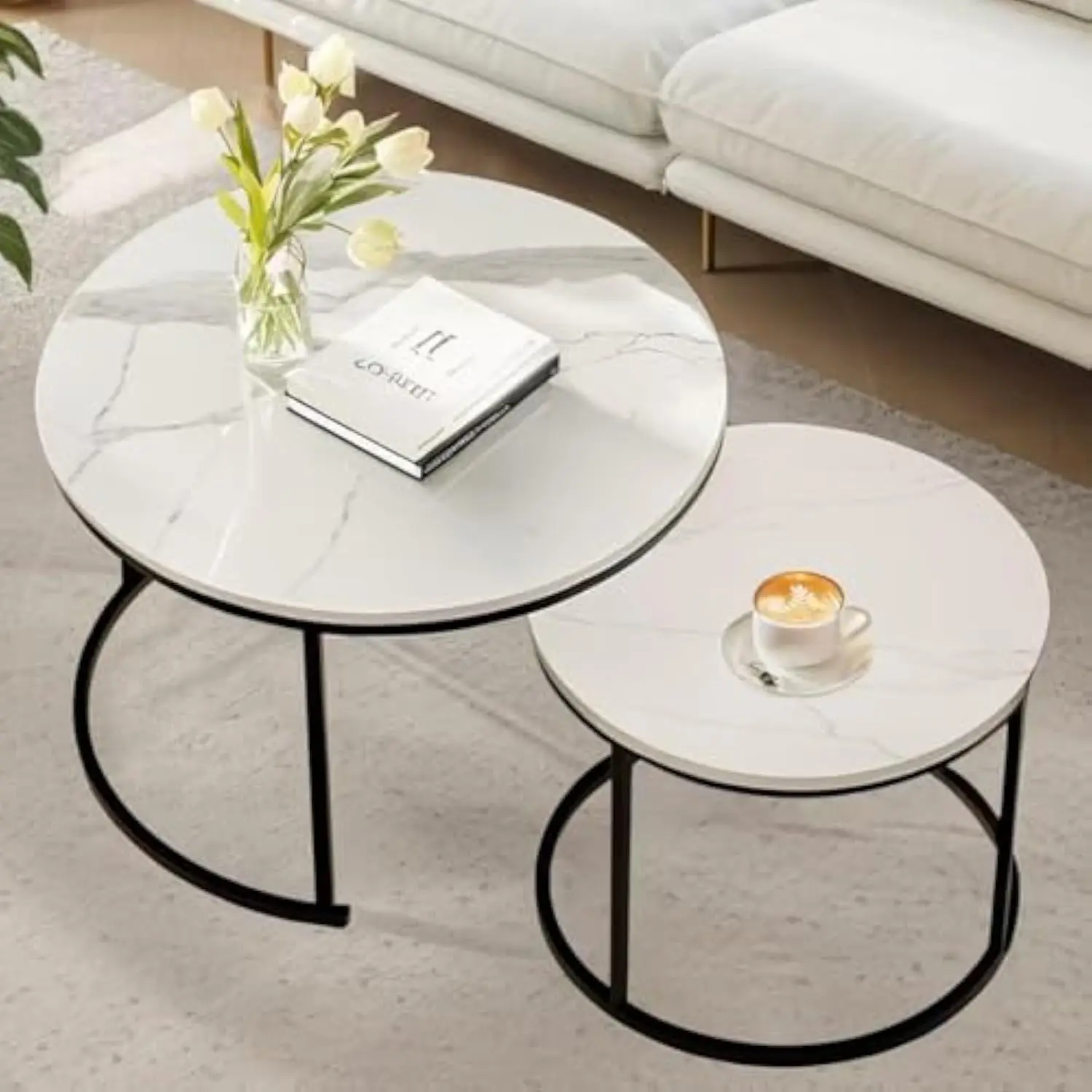
Browse our collection of round coffee tables for pieces that beautifully accommodate these styling techniques.
Essential Styling Elements for Your Vintage Coffee Table
The items you select to display on your vintage coffee table should enhance—not compete with—its natural beauty. Here are versatile styling elements that complement most vintage tables:
Books and Reading Material
* Art and design books with complementary colors to your table
* Vintage hardcovers with jackets removed to reveal textured bindings
* Stack books horizontally with largest at bottom, creating platforms for smaller objects
Decorative Trays and Vessels
* Trays in materials that complement your table (brass with walnut, ceramic with teak)
* Low bowls for containing small collections or seasonal elements
* Vintage containers that echo your table’s era for authentic styling
Natural Elements
* Small potted plants or succulents (ensure bottom has protection for wood surfaces)
* Interesting stones, driftwood, or botanical elements
* Fresh or dried flower arrangements in appropriate scale
Personal and Artistic Objects
* Small sculptures or artistic objects that reflect your interests
* Vintage items that relate to the table’s era
* Meaningful personal treasures that create conversation
Practical Elements with Style
* Decorative boxes that hide remotes or small necessities
* Unique coasters that protect while adding visual interest
* Candles in holders that complement your table’s materials
When selecting these elements, vary textures significantly—pair smooth ceramics with rough natural materials, or sleek metal with soft fabric. This textural contrast makes arrangements more interesting while highlighting your vintage table’s unique material qualities.
Consider how these items might change seasonally while maintaining core elements that work with your aged wood vintage coffee table. Seasonal adjustments—like swapping botanical elements or changing color accents—keep your styling fresh without requiring complete overhauls.
Arrangement Strategies: From Minimalist to Maximalist
Your personal aesthetic and the table’s size will determine which styling approach works best. Consider these three distinct strategies:
The Minimalist Approach
* 1-3 carefully selected statement pieces
* Ample negative space showcasing the table’s beauty
* Perfect for tables with exceptional wood grain or distinctive features
* Styling formula: 1 low stack of books + 1 distinctive object + 1 small plant
* Best for smaller vintage tables or those with unique design details
The Moderate Approach
* 5-7 items arranged in purposeful groupings
* Balance between display and function
* Incorporates both decorative and practical elements
* Styling formula: 1 tray with 3 small objects + 1 stack of books with object on top + 1 plant
* Suits most average-sized vintage coffee tables
The Layered Approach
* Multiple thoughtfully arranged groupings
* Creates visual richness without appearing cluttered
* Incorporates varied heights, textures, and purposes
* Styling formula: 1 central tray with multiple small objects + 2-3 book stacks with objects + multiple small decorative items + plants or flowers
* Works for larger vintage tables with substantial surface area
For any approach, maintain these guidelines:
* Create deliberate, not random arrangements
* Ensure items relate to each other through color, material, or theme
* Leave enough empty space for practical use (setting down drinks)
* Avoid blocking conversation sight lines with tall center items
Your vintage table’s style also influences which approach works best—Mid-Century pieces often shine with minimalist styling, while Victorian tables can handle more layered arrangements.
Our selection of solid wood coffee tables offers options for every styling preference, from sleek minimalist designs to substantial pieces that accommodate layered styling.
Adapting Your Style to Your Vintage Coffee Table’s Era
Honoring your vintage coffee table’s historical context creates more authentic styling. Here’s how to adapt your approach based on specific eras:
Mid-Century Modern Tables (1940s-1970s)
* Styling approach: Clean, uncluttered arrangements with breathing room
* Complementary accessories: Geometric ceramics, brass accents, abstract art books
* Color palette: Warm woods paired with mustard yellow, olive green, burnt orange, teal
* Materials to incorporate: Teak, walnut, rosewood, brass, glass, ceramic
* Balance with: Simple ceramic vessels, low profile accessories, books on design or art
Art Deco Tables (1920s-1930s)
* Styling approach: Symmetrical, glamorous arrangements with bold contrasts
* Complementary accessories: Crystal decanters, metallic objects, black and white photos
* Color palette: Rich woods with black, white, gold, deep blues and greens
* Materials to incorporate: Glass, mirror, chrome, exotic woods, lacquer
* Balance with: Geometric patterns, cocktail accessories, vintage photography books
Victorian/Traditional Tables (1837-1901)
* Styling approach: Formal, symmetrical arrangements with fine details
* Complementary accessories: Silver frames, porcelain objects, traditional books
* Color palette: Dark woods with burgundy, navy, forest green, cream
* Materials to incorporate: Mahogany, walnut, marble, silver, crystal
* Balance with: Ornate small boxes, vintage hardcover books, traditional floral elements
Industrial/Rustic Tables (Early 20th century)
* Styling approach: Casual, functional groupings with texture contrasts
* Complementary accessories: Metal containers, vintage tools, natural elements
* Color palette: Reclaimed woods with black, copper, neutral earth tones
* Materials to incorporate: Iron, steel, zinc, reclaimed timber, leather
* Balance with: Pottery, vintage tins, plants in simple containers
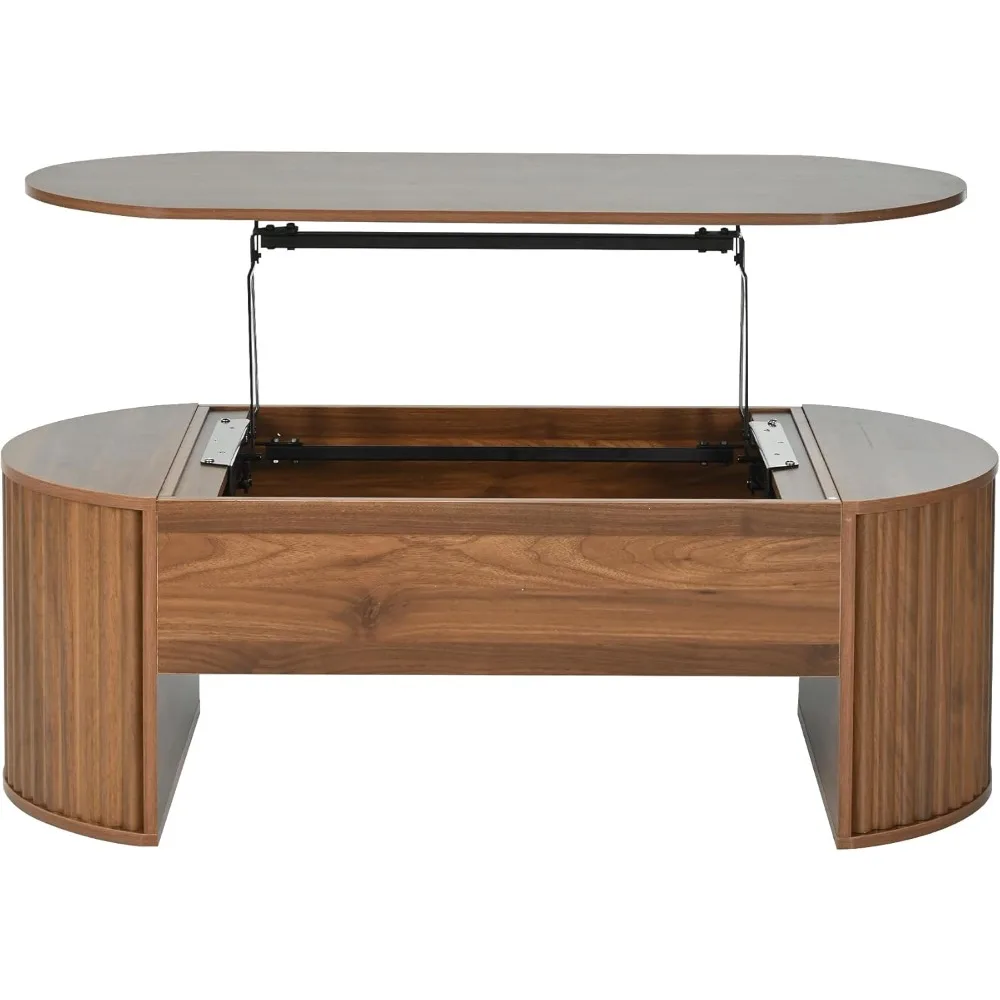
Each era’s distinctive aesthetic provides valuable guidance for styling decisions. For deeper understanding of period-appropriate styling, explore our black mid-century coffee table design guide with additional historical context.
Complementary Room Elements That Enhance Your Vintage Table
Your vintage coffee table doesn’t exist in isolation—surrounding elements should create a cohesive framework that highlights its beauty:
Area Rugs: Creating the Perfect Foundation
* Size: Extend at least 18-24 inches beyond the coffee table on all sides
* Style pairings:
* Mid-Century tables: Solid colors, subtle geometric patterns, low pile
* Art Deco tables: Bold geometric patterns, high contrast designs
* Victorian tables: Traditional patterns with borders, rich colors
* Industrial tables: Natural fibers, simple stripes, vintage-inspired patterns
Side Tables: Supportive Accents
* Relationship approach: Either match your coffee table exactly or intentionally contrast
* For matching: Find pieces from same era with similar woods and details
* For contrasting: Select pieces with complementary scale and function but different materials
* Placement: Position at comfortable arm’s reach from seating, typically 18-24 inches high
Lighting: Highlighting Your Vintage Piece
* Table lamps: Position to cast gentle highlighting on special table details
* Floor lamps: Arc or adjustable styles can direct light toward the coffee table area
* Ambient lighting: Ensure evening lighting adequately illuminates your styled arrangement
Wall Decor: Creating Context
* Select art that echoes elements from your vintage table (colors, era, materials)
* Consider vintage advertisements or designs from your table’s original era
* Position key art pieces where they’ll be visible beyond the coffee table when seated
Textiles: Softening and Connecting
* Sofa cushions: Include at least one textile that references your coffee table’s color or era
* Throws: Choose weights and textures that balance your table’s visual weight
* Curtains: Either neutral backgrounds or subtle nods to your vintage table’s design heritage
Our side and end tables collection features pieces specifically designed to complement vintage coffee tables while maintaining design coherence.
Care and Maintenance for Lasting Beauty
Proper care ensures your vintage coffee table remains beautiful for generations. Different materials require specific approaches:
Solid Wood Tables
* Regular dusting with a soft, lint-free cloth
* Clean with mild soap solution (few drops in water), wipe immediately with dry cloth
* Apply appropriate wood polish or oil 2-4 times yearly (test in inconspicuous spot first)
* Use coasters and placemats to prevent water rings and heat damage
* Address watermarks on finished wood with a mixture of equal parts vinegar and olive oil
Glass Elements
* Clean with diluted vinegar solution or commercial glass cleaner
* Apply to cloth first, not directly to glass (especially for glass attached to wood)
* Check and tighten any hardware holding glass components regularly
Metal Components
* Dust regularly with dry cloth
* For brass: clean with mixture of lemon juice and baking soda, rinse and dry thoroughly
* For chrome/steel: wipe with damp cloth, dry immediately to prevent spotting
* Apply appropriate metal polish sparingly when finishes dull
Leather Surfaces
* Dust regularly and clean spills immediately with dry cloth
* Apply appropriate leather conditioner twice yearly
* Avoid placing leather tables in direct sunlight
Preventative measures make a significant difference:
* Use felt pads under all objects placed on the table
* Rotate decorative items periodically to prevent uneven aging
* Position tables away from direct sunlight and heating sources
* Maintain consistent indoor humidity (30-50%) to prevent wood cracking
Our teak coffee tables require specific care to maintain their rich color and beauty—these maintenance practices ensure your investment remains stunning for years.
Mid-Century Modern End Table Sets of 2, Mid-Century Modern Square Side & End Tables, Mid-Century Modern White Side & End Tables
$348.24 Select options This product has multiple variants. The options may be chosen on the product pageMid-Century Modern Solid Wood Coffee Tables, Mid-Century Modern Teak Coffee Tables
$879.95 Select options This product has multiple variants. The options may be chosen on the product pageMid-Century Modern Danish Coffee Tables, Mid-Century Modern Oval Coffee Tables, Mid-Century Modern Solid Wood Coffee Tables
$390.05 Select options This product has multiple variants. The options may be chosen on the product pageMid-Century Modern Nesting Side & End Tables, Mid-Century Modern Nesting Table Sets, Mid-Century Modern Round Side & End Tables
Price range: $239.35 through $273.06 Select options This product has multiple variants. The options may be chosen on the product pageMid-Century Modern End Table Sets of 2, Mid-Century Modern Walnut Side & End Tables
Price range: $978.89 through $1,957.38 Select options This product has multiple variants. The options may be chosen on the product pageMid-Century Modern Coffee & End Table Sets, Mid-Century Modern Coffee Table Sets, Mid-Century Modern Oval Coffee Tables
Price range: $257.48 through $331.04 Select options This product has multiple variants. The options may be chosen on the product page
Seasonal Refreshes: Keeping Your Vintage Table Styling Current
Periodic updates keep your coffee table display fresh while honoring your vintage piece’s timeless quality:
Spring/Summer Refresh
* Incorporate lighter colors and natural elements
* Add fresh flowers or bright green plants
* Switch heavy objects for lighter, brighter alternatives
* Introduce glass or crystal elements that catch summer light
Fall/Winter Updates
* Introduce warmer tones and heavier textures
* Replace bright accessories with deeper, richer colors
* Add natural elements like pinecones, wood slices, or dried botanicals
* Include candles or softer lighting elements for winter ambiance
Create a “base styling” foundation that remains consistent year-round:
* Keep larger books or a favorite decorative tray as constants
* Maintain a consistent general arrangement structure
* Swap only 2-3 elements seasonally rather than everything
* Store seasonal coffee table accessories in labeled containers for easy rotation
This approach to decorating black mid-century coffee tables and other vintage pieces allows your special furniture to remain the star while the supporting elements create seasonal freshness.
Is Your Vintage Coffee Table The Right Size? Practical Considerations
Proper sizing and placement significantly impact both the aesthetics and functionality of your vintage coffee table:
Ideal Measurements
* Distance from sofa: 14-18 inches (35-45 cm)
* Table height: 1-2 inches (2.5-5 cm) lower than sofa seat height
* Table length: Approximately two-thirds the length of your sofa
* Clearance around table: Minimum 30 inches (76 cm) for traffic flow
Solutions for Size Challenges
If your vintage table is too small:
* Add a decorative tray to create visual weight
* Pair with a matching side table to create a nested arrangement
* Use larger, bolder styling elements to increase presence
If your vintage table is too large:
* Create distinct zones on the table surface through styling
* Ensure at least 16 inches (40 cm) of walking space around all sides
* Consider repositioning seating to accommodate the larger piece
Height Considerations
* Standard coffee table height: 16-18 inches (40-45 cm)
* Many vintage tables sit lower: 12-16 inches (30-40 cm)
* If your table is exceptionally low or high, adjust surrounding seating accordingly
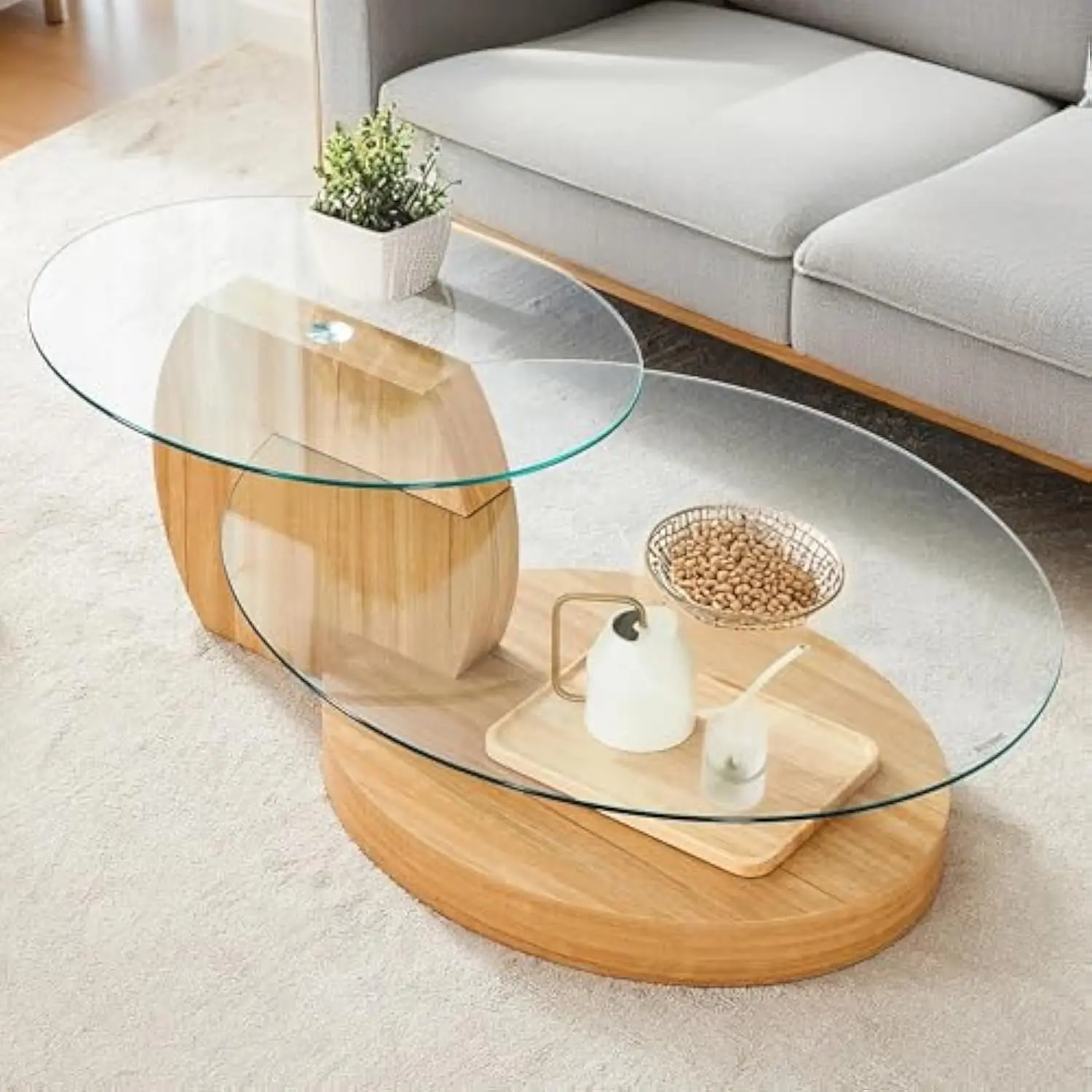
For homes with limited space or unusually proportioned rooms, learning to expertly arrange rooms with large coffee tables can help integrate even challenging vintage pieces successfully.
Finding the Perfect Vintage Coffee Table (If You’re Still Looking)
If you’re still searching for the ideal vintage coffee table, consider these important factors:
Key Selection Criteria
* Authenticity: Look for maker’s marks, proper construction techniques, and period-appropriate materials
* Condition: Check structural integrity, especially at joints and stress points
* Proportions: Measure your space carefully before purchasing
* Functionality: Consider how the piece will be used daily
* Design compatibility: Choose a style that complements your existing décor
Questions to Ask Sellers
* What is the exact age and origin of the piece?
* Has it been restored or refinished?
* Are there any structural issues not visible in photos?
* What materials were used in construction?
* Are there any special care requirements?
Inspection Checklist
* Test stability by gently rocking the table
* Check all joints for tightness and proper alignment
* Examine surfaces for damage not congruent with normal patina
* Verify that any moving parts (drawers, extensions) function properly
* Smell the piece for musty odors that might indicate mold or mildew
Our guide to vintage-style coffee tables provides additional insights for discerning shoppers looking for authentic pieces with genuine character and craftsmanship.
Common Styling Mistakes to Avoid
Even design enthusiasts make these frequent errors when styling vintage coffee tables:
Overcrowding the surface: Too many objects diminish impact and functionality. Edit ruthlessly, keeping only items that serve a purpose or bring genuine joy.
Blocking conversation: Tall arrangements in the center create visual and practical barriers. Keep central items below eye level when seated.
Ignoring scale relationships: Tiny objects get lost on large tables while oversized items overwhelm smaller tables. Select accessories proportional to your table size.
Creating unstable arrangements: Precarious stacks or wobbly items invite accidents. Ensure every element sits securely, especially in households with children or pets.
Over-matching eras: Creating a time-capsule effect by exclusively using items from your table’s era feels artificial. Mix vintage with contemporary for authentic, lived-in appeal.
Neglecting function: Coffee tables need space for coffee! Leave room for practical use—ideally 1/3 to 1/2 of the surface clear.
Using inappropriate cleaning products: Harsh chemicals damage vintage finishes. Always research proper care for specific materials.
Forgetting to rotate items: Keeping arrangements static leads to dust accumulation and sun damage. Refresh displays regularly.
For more versatile options that help avoid these common pitfalls, explore our full collection of mid-century modern coffee tables.
Should You Refinish or Embrace the Patina?
One of the most significant decisions facing vintage furniture owners is whether to restore or preserve a piece’s existing condition:
When to Embrace the Patina
* The aging enhances character without compromising structure
* The piece has historical significance that would be diminished by refinishing
* Surface marks tell a story or create distinctive beauty
* The patina has developed an attractive, even appearance
When to Consider Refinishing
* Structural integrity is compromised
* Finishes are actively deteriorating (flaking, peeling)
* Water damage or stains significantly detract from appearance
* Previous poor-quality refinishing needs correction
Middle-Ground Approaches
* Light cleaning and conditioning without full refinishing
* Spot-treating damaged areas while preserving overall patina
* Using restoration wax to revitalize without stripping original finishes
* Addressing structural issues while maintaining aesthetic aging
Professional assistance is recommended for valuable pieces or when you’re uncertain about appropriate techniques. An experienced furniture restorer can often preserve a piece’s character while addressing functional concerns.
When evaluating restoration needs, learning to identify real wood coffee tables helps determine appropriate techniques and products for your specific vintage piece.
Real Rooms Showcase: Vintage Coffee Tables in Action
Drawing inspiration from successfully styled spaces can help you envision possibilities for your own vintage coffee table:
Modern Minimalist + Mid-Century Table
* Clean-lined contemporary seating in neutral tones
* Vintage walnut coffee table with tapered legs as focal point
* Styling: Single oversized art book, one sculptural object, small plant
* Key takeaway: The contrast between new and old creates visual interest while minimal styling highlights the table’s design
Eclectic Bohemian + Victorian Table
* Colorful, layered textiles throughout the space
* Ornate antique table with dark wood and decorative details
* Styling: Collection of global objects, vintage books, brass accessories
* Key takeaway: The vintage table grounds the eclectic elements while contributing to the collected-over-time aesthetic
Contemporary Traditional + Art Deco Table
* Classic upholstered furniture with updated fabrics
* Glass and wood Art Deco table with geometric details
* Styling: Silver photo frames, crystal decanter, stack of design books
* Key takeaway: The vintage table adds character to an otherwise conventional space
Industrial Modern + Rustic Table
* Sleek contemporary seating with metal accents
* Reclaimed wood coffee table with visible history
* Styling: Metal containers, vintage industrial objects, succulent plants
* Key takeaway: The weathered table softens the modern elements while complementing the industrial theme
These real-world examples demonstrate how vintage coffee tables can enhance vastly different design schemes when styled thoughtfully. The common thread is intentionality—creating deliberate relationships between the vintage piece and its surroundings.
By applying the principles and techniques outlined in this guide, your vintage coffee table will become not just a functional surface, but a design cornerstone that elevates your entire living space with authentic character and timeless appeal.

